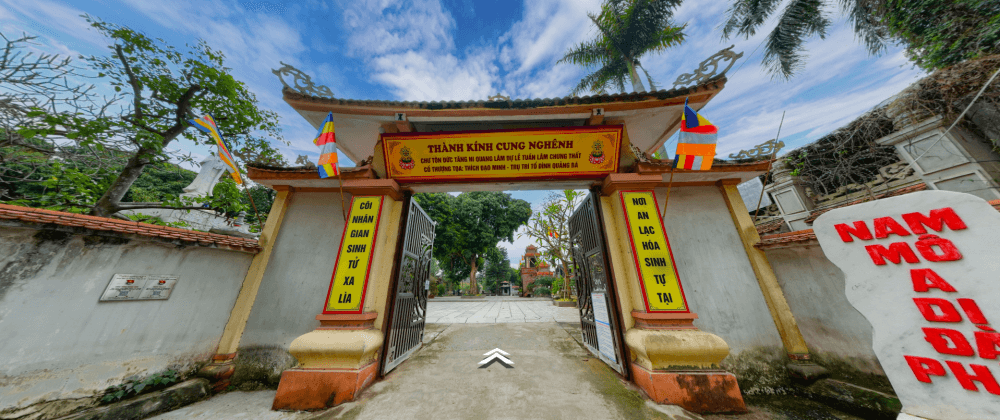

Introduce
Local people call Hoang An pagoda as Quang Ba pagoda because it is now located in Quang Ba village, Quang An ward, Tay Ho district, Hanoi.
The original name of the pagoda is "Bao An". Legend has it that the pagoda was first built in the Ly dynasty by Zen master Ngo An (1019-1088) with some small altars. By 1628, the pagoda was built to be larger. In the Le dynasty, Princess Nguyen Thi Ngoc Tu, the daughter of Emperor Nguyen Hoang, was the wife of “Thanh Do Vuong” Trinh Trang (1623-1657) rebuilt the pagoda, enlarged it and kept the name “Bao An Tu” and located in Quang Bo Ward (Quang Ba District), Vinh Thuan District, Phung Thien Canton, Thang Long Citadel.
In 1821 the King Minh Menh visited the pagoda and did some Buddhist ceremonies.
In 1841, King Thieu Tri was crowned. The next year, he went to visit the pagoda and changed the name of the pagoda to “Hoang An”. The king also paid to repair the pagoda because of many dilapidated and sent the academic at the Academy to write inscriptions to record this. The pagoda was remodeled in 1884, the Ministry of Defense and General Director of Ha Ninh, Mai Cong Ngoc used his money to cast a bronze statue of Amitabha Buddha. In 1923, the temple was restored and carved a number of wooden statues.
The pagoda is located in the middle of the West Lake area, where there are dreamlike landscapes and architectural with sculptural works of high artistic and aesthetic value, such as wooden hammocks with carved art which show the philosophy of human and artistic sophistication, along with the statues and brass bell from the Le dynasty, ... Therefore, long ago, Hoang An pagoda is not only the desire to meet of Buddhist but also an attractive tourist destination for domestic and foreign tourists.
Along its history, Quang Ba Pagoda is both a place for worshiping Buddha, and also a center of cultural and spiritual activities of a community. This is the place where many famous monks have been buried in the struggle for national defense and national construction. Pham Ngoc Dat, a monk there was the benefactor of Uncle Ho's secretive activities in Thailand.
In early 1969, Uncle Ho visited the pagoda and open a training class for monks who had merit with the revolution.
In the period of anti-French resistance the pagoda was one of the safe revolutionary bases of the Party. The monks and nuns of the pagoda have hidden the protection of cadres. The foundation of the pagoda still has a hidden secret tunnel, where revolutionary officers shelter. The high building adjacent to the monastery is a very convenient place for officers of the revolution to come and meet each other with the help of the monks.
During the anti-American period, the pagoda was the headquarters of the Information Army.
Since the Ly dynasty, Quang Ba Pagoda has been a famous relic of Thang Long citadel.
Overall, the pagoda now includes: garden, main pagoda, two houses, ancestors altar room, monk rooms, garden tower. The architecture of the pagoda is arranged in harmony and located in a spacious space. The pagoda turns south, overlooking the West Lake. The old style of the pagoda which hidden under the green trees create the solemnity of the pagoda.
The pagoda has a structure of "nội công ngoại quốc" - the common pagoda architecture in Vietnam, meaning that the interior is shaped like the word “Cong” (工), and the outside is shaped like the character “Quoc” (国).
The front house has 5 parts with tile roof, the middle of the roof is the tigers embracing the sun. In front of the house are two pillars with the top shaped like lotus.
The wall of the pagoda was built with wooden-hammer brick from the 15th - 17th centuries. The interior plan has six rows of round wooden columns, and placed on the legs is a smooth green rock. The roof support frame consists of six sets of trusses. The truss is made in the style of "chồng rường - con nhị" - A traditional Vietnamese wooden frame. The pagoda is decorated with silk. The three middle compartments have "bức bàn" doors (Traditional door style in ancient Vietnamese wooden houses) made in the style of "thượng song – hạ bản". The architecture is simply smooth and flat. The floor is tiled with Bat Trang tiles.
The main palace has three rooms, and is built along the back with a style of overlapping walls and Vietnamese roof tiles. There are four rows of round wooden columns supporting the roof, with the columns designed in the "thượng thu hạ thách" style placed on smooth green stone blocks. The roof frame consists of four rafters, designed in the "chồng rường" style, and the floor is tiled with Bat Trang bricks.
The houses in the two sides at the upper chamber have tile roof. The first three rooms are connected to the ancestor altar room to serve as a place to meet guests. Four rooms in the back were built to make rooms for the monks. The roof truss are made simple and the floor is covered with the Bat Trang brick.
In the pagoda there is a bonsai garden with many kinds of flowers such as Camellia Japonica, Osmanthus fragrans, roses, peaches, kumquat which fragrant ascetic scent in all four season. In particular, there is a sumptuous bodhi tree planted in the garden.
The layout of the temple as follows:
- The first Class: Statue of the Buddha.
- The Second Class: Nam Hai Bodhisattva Statue.
- The Third class: Amitabha statue, the two sides are statues of Bodhisattvas.
- The Fourth class: The statue of the three sacred flowers.
- The fifth class: Statue of some Bodhisattvas.
- The Sixth class: Jade Emperor statue.
- The Seventh Grade: The Tower of nine dragons and the New Birth of Shakyamuni.
Quang Ba pagoda now preserves a great set of valuable relics of art history.
Thirty round statues are covered with gorgeous gold lacquer and elaborate work of art from the XVII, XVIII, XIX centuries. Among them, the Nam Hai Bodhisattva statue is very special, although the statue size is not very large. The statue has a benevelant face, dressed with a lot of folds, in meditation posture, step on the small lotus base.
In the pagoda there are still many precious relics: two brass bells, one of which is the is made in the reign of King Le Hien Tong (1743), the bell with the height of 1.5m and the diameter of 80 cm. The ring is carved out of four Han characters, "Long An pagoda bell", the body bell divided into four segments symbolizes the four seasons, on the body of the bell inscription of the work of casting bell. Smaller ring tone dating back to the Nguyen Dynasty.
Thirty tablets made of smooth blue stones. A tablet set in 1700. In particular, there is an inscription depicting a nun. Many people think it is the image of Princess Ngoc Tu. The remaining tablets are from the Nguyen Dynasty. The temple also holds many horizontal, parallel Han sentences.
Quang Ba Pagoda is a famous monument, a scenic spot of West Lake, ranked by the State Historical - Cultural Monument at the National Decision No. 1728-QD-BVH dated 2/10/1991 of the Ministry Culture and Information (now the Ministry of Culture, Sports and Tourism).
Artifacts
Map
Nearby Places
No. 43C, alley 497, quarter 2, group 15, Lac Long Quan Street, Nhat Tan Ward
1.25Km
No.6, Lane 319, An Duong Vuong Street, Phu Thuong ward
3.6Km
Lane 242, Lac Long Quan Street, Buoi Ward, Tay Ho District, Hanoi.
No. 20, Lane 472, Cluster 3, Lac Long Quan Road, Nhat Tan Ward, Tay Ho District, Hanoi.
No. 35, Lane 416, Lac Long Quan Road, Nhat Tan Ward, Tay Ho District, Hanoi.
3.03Km
No. 07, Lane 30, Tay Ho Road, Quang An Ward, Tay Ho District, Hanoi.
0.55Km
Residential Area No. 5 (No. 3, Lane 200, Au Co Road), Tu Lien Ward, Tay Ho District, Hanoi.
0.87Km
Residential Area No. 5 (No. 3, Lane 200, Au Co Road), Tu Lien Ward, Tay Ho District.
1.36Km